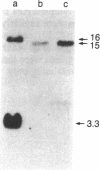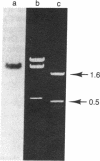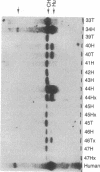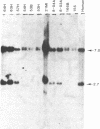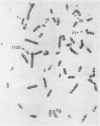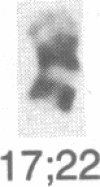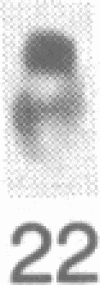Abstract
A clone that cross-hybridizes with a mouse p53 probe has been isolated from a cDNA library of simian virus 40-transformed human fibroblasts. This cloned human p53 cDNA was used as a probe to examine DNAs obtained from human-rodent somatic cell hybrids that have segregated human chromosomes. The results show that the human p53 gene is located on chromosome 17. In addition, Southern analysis of hybrids prepared from human cells containing a chromosome 17 translocation allowed regional localization of the human p53 gene to the most distal band on the short arm of this chromosome (17p13). Localization of the p53 gene to 17p13 was confirmed by in situ hybridization of metaphase spreads with the human p53 probe.
Full text
PDF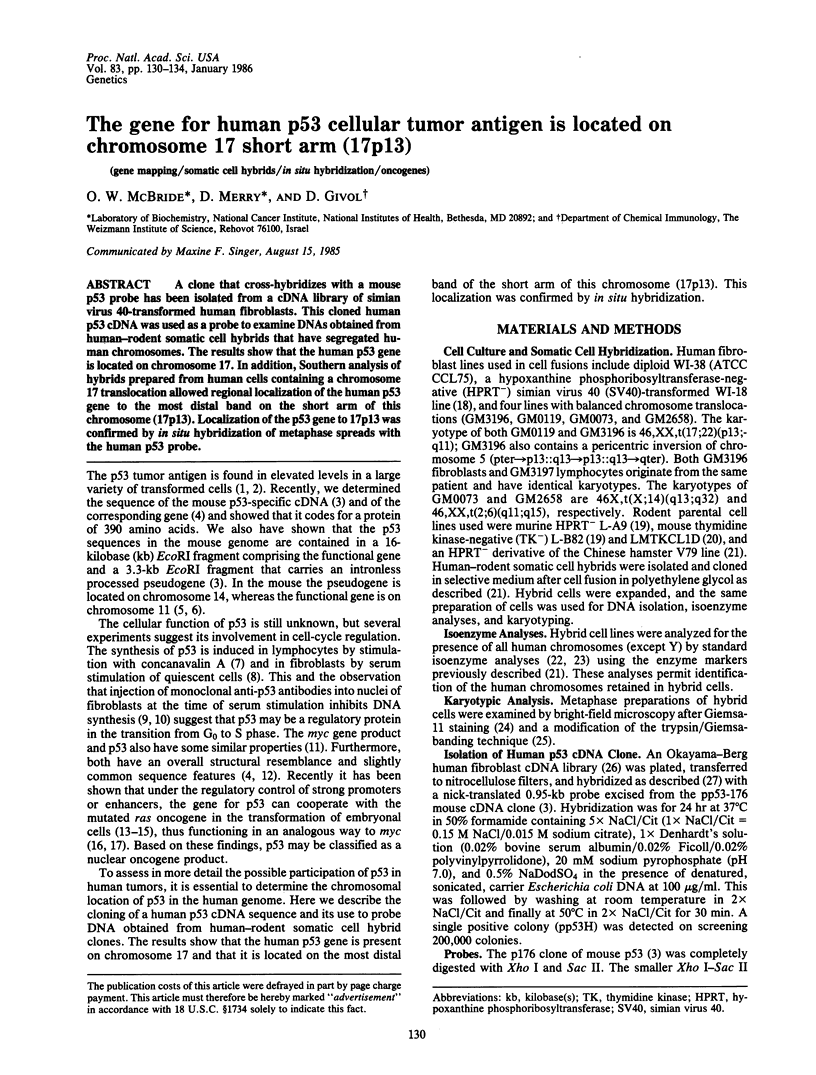
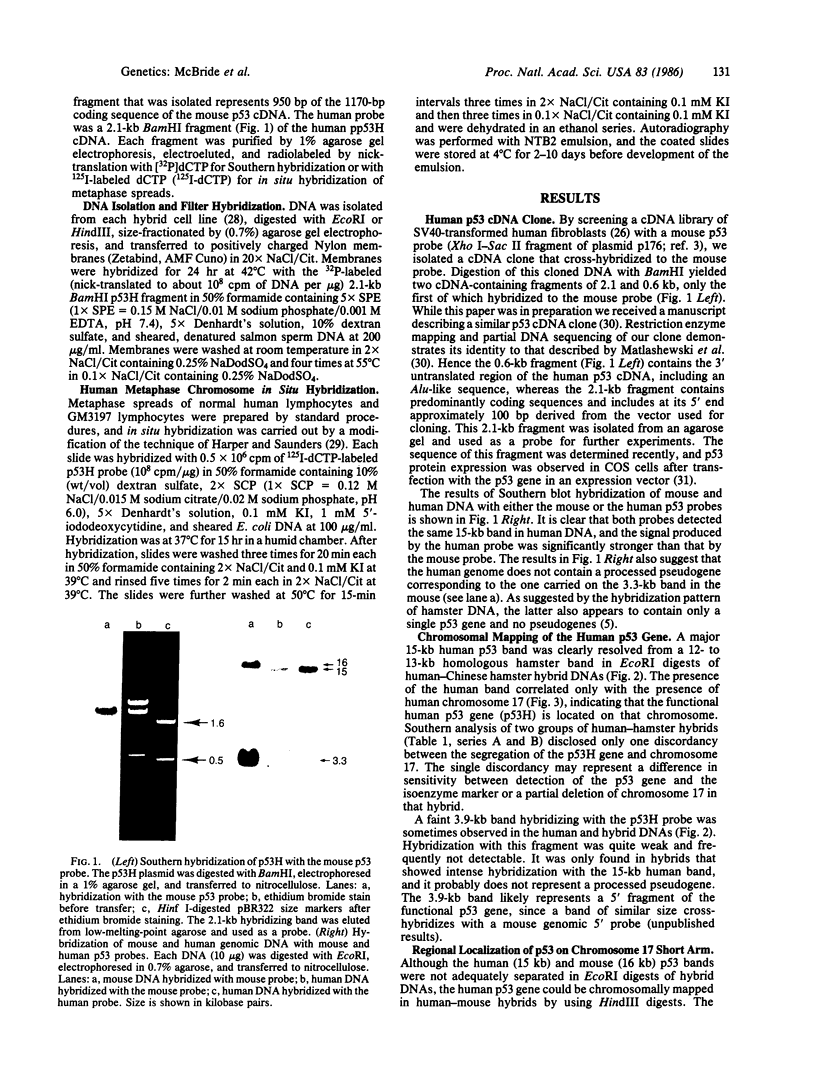
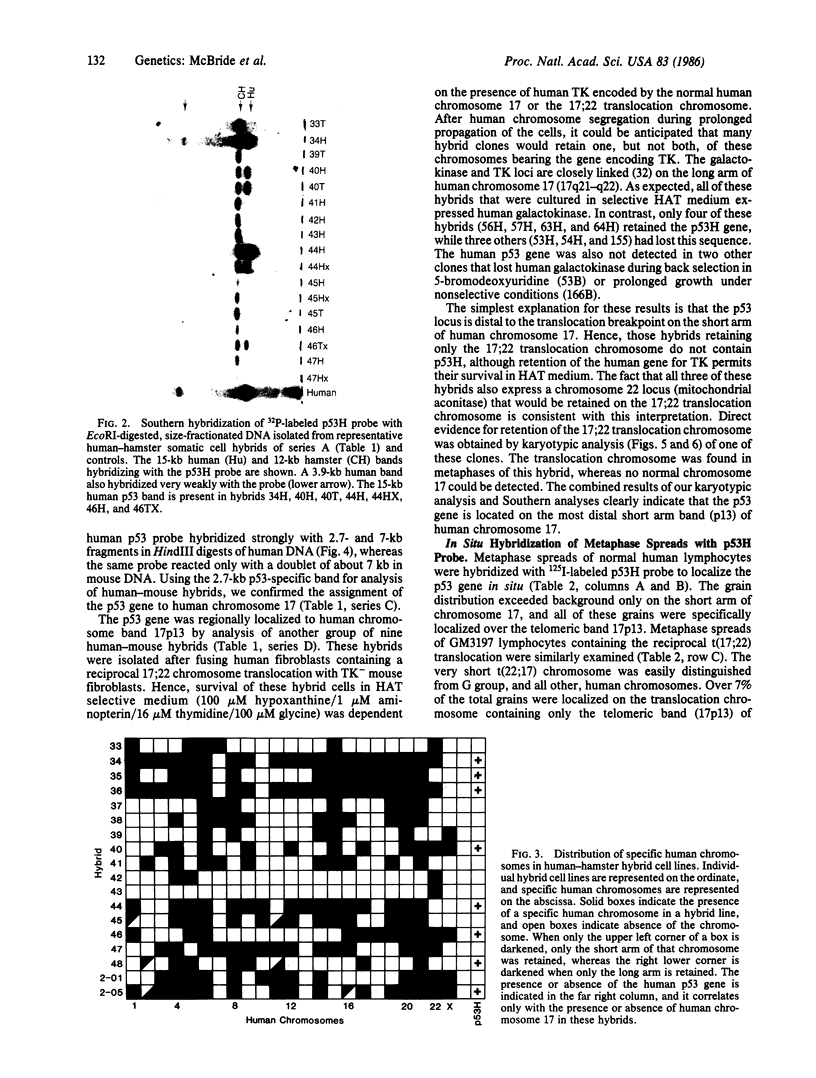
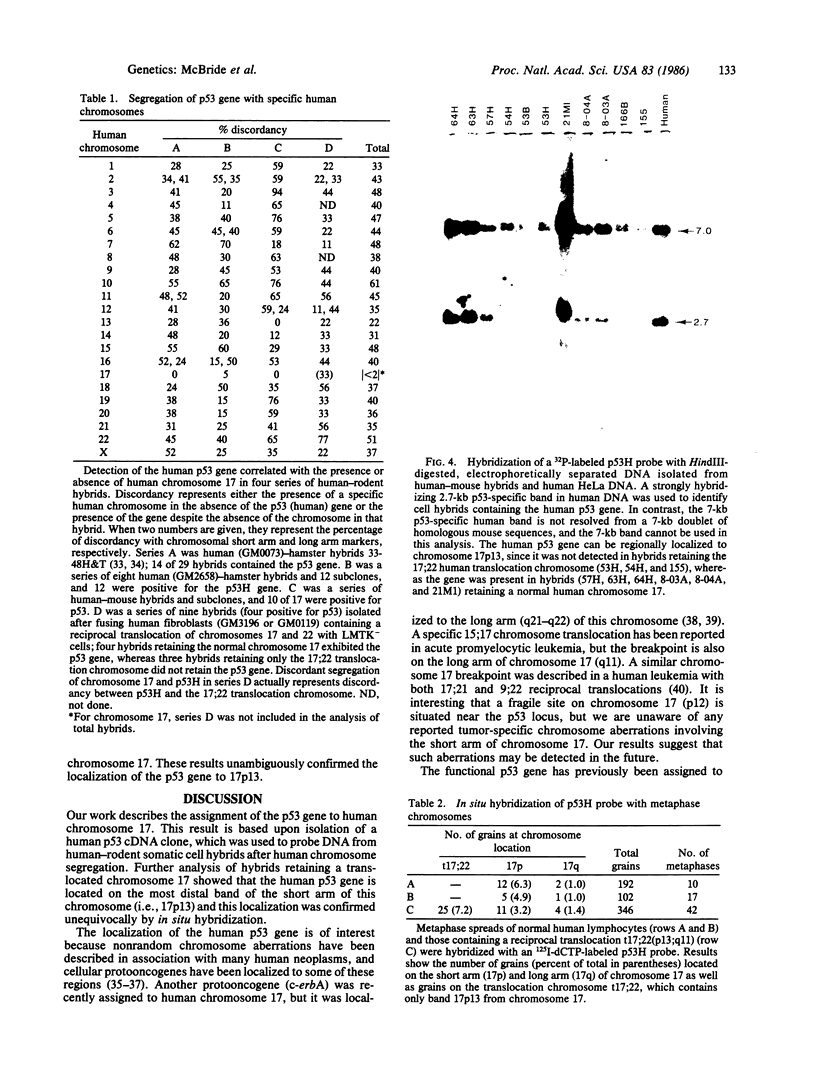
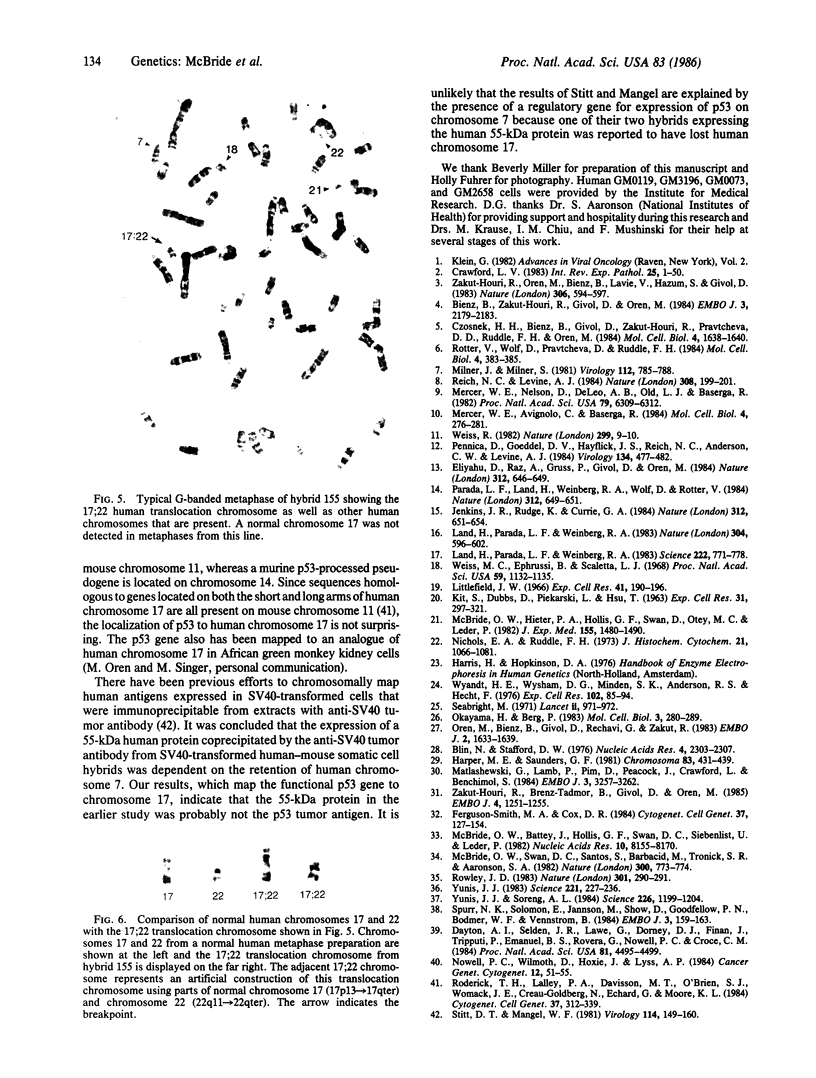
Images in this article
Selected References
These references are in PubMed. This may not be the complete list of references from this article.
- Bienz B., Zakut-Houri R., Givol D., Oren M. Analysis of the gene coding for the murine cellular tumour antigen p53. EMBO J. 1984 Sep;3(9):2179–2183. doi: 10.1002/j.1460-2075.1984.tb02110.x. [DOI] [PMC free article] [PubMed] [Google Scholar]
- Blin N., Stafford D. W. A general method for isolation of high molecular weight DNA from eukaryotes. Nucleic Acids Res. 1976 Sep;3(9):2303–2308. doi: 10.1093/nar/3.9.2303. [DOI] [PMC free article] [PubMed] [Google Scholar]
- Crawford L. The 53,000-dalton cellular protein and its role in transformation. Int Rev Exp Pathol. 1983;25:1–50. [PubMed] [Google Scholar]
- Czosnek H. H., Bienz B., Givol D., Zakut-Houri R., Pravtcheva D. D., Ruddle F. H., Oren M. The gene and the pseudogene for mouse p53 cellular tumor antigen are located on different chromosomes. Mol Cell Biol. 1984 Aug;4(8):1638–1640. doi: 10.1128/mcb.4.8.1638. [DOI] [PMC free article] [PubMed] [Google Scholar]
- Dayton A. I., Selden J. R., Laws G., Dorney D. J., Finan J., Tripputi P., Emanuel B. S., Rovera G., Nowell P. C., Croce C. M. A human c-erbA oncogene homologue is closely proximal to the chromosome 17 breakpoint in acute promyelocytic leukemia. Proc Natl Acad Sci U S A. 1984 Jul;81(14):4495–4499. doi: 10.1073/pnas.81.14.4495. [DOI] [PMC free article] [PubMed] [Google Scholar]
- Eliyahu D., Raz A., Gruss P., Givol D., Oren M. Participation of p53 cellular tumour antigen in transformation of normal embryonic cells. Nature. 1984 Dec 13;312(5995):646–649. doi: 10.1038/312646a0. [DOI] [PubMed] [Google Scholar]
- Ferguson-Smith M. A., Cox D. R. Report of the Committee on the Genetic Constitution of Chromosomes 13, 14, 15, 16 and 17. Cytogenet Cell Genet. 1984;37(1-4):127–154. doi: 10.1159/000132007. [DOI] [PubMed] [Google Scholar]
- Harper M. E., Saunders G. F. Localization of single copy DNA sequences of G-banded human chromosomes by in situ hybridization. Chromosoma. 1981;83(3):431–439. doi: 10.1007/BF00327364. [DOI] [PubMed] [Google Scholar]
- Jenkins J. R., Rudge K., Currie G. A. Cellular immortalization by a cDNA clone encoding the transformation-associated phosphoprotein p53. Nature. 1984 Dec 13;312(5995):651–654. doi: 10.1038/312651a0. [DOI] [PubMed] [Google Scholar]
- KIT S., DUBBS D. R., PIEKARSKI L. J., HSU T. C. DELETION OF THYMIDINE KINASE ACTIVITY FROM L CELLS RESISTANT TO BROMODEOXYURIDINE. Exp Cell Res. 1963 Aug;31:297–312. doi: 10.1016/0014-4827(63)90007-7. [DOI] [PubMed] [Google Scholar]
- Land H., Parada L. F., Weinberg R. A. Cellular oncogenes and multistep carcinogenesis. Science. 1983 Nov 18;222(4625):771–778. doi: 10.1126/science.6356358. [DOI] [PubMed] [Google Scholar]
- Land H., Parada L. F., Weinberg R. A. Tumorigenic conversion of primary embryo fibroblasts requires at least two cooperating oncogenes. Nature. 1983 Aug 18;304(5927):596–602. doi: 10.1038/304596a0. [DOI] [PubMed] [Google Scholar]
- Littlefield J. W. The use of drug-resistant markers to study the hybridization of mouse fibroblasts. Exp Cell Res. 1966 Jan;41(1):190–196. doi: 10.1016/0014-4827(66)90558-1. [DOI] [PubMed] [Google Scholar]
- Matlashewski G., Lamb P., Pim D., Peacock J., Crawford L., Benchimol S. Isolation and characterization of a human p53 cDNA clone: expression of the human p53 gene. EMBO J. 1984 Dec 20;3(13):3257–3262. doi: 10.1002/j.1460-2075.1984.tb02287.x. [DOI] [PMC free article] [PubMed] [Google Scholar]
- McBride O. W., Battey J., Hollis G. F., Swan D. C., Siebenlist U., Leder P. Localization of human variable and constant region immunoglobulin heavy chain genes on subtelomeric band q32 of chromosome 14. Nucleic Acids Res. 1982 Dec 20;10(24):8155–8170. doi: 10.1093/nar/10.24.8155. [DOI] [PMC free article] [PubMed] [Google Scholar]
- McBride O. W., Hieter P. A., Hollis G. F., Swan D., Otey M. C., Leder P. Chromosomal location of human kappa and lambda immunoglobulin light chain constant region genes. J Exp Med. 1982 May 1;155(5):1480–1490. doi: 10.1084/jem.155.5.1480. [DOI] [PMC free article] [PubMed] [Google Scholar]
- McBride O. W., Swan D. C., Santos E., Barbacid M., Tronick S. R., Aaronson S. A. Localization of the normal allele of T24 human bladder carcinoma oncogene to chromosome 11. Nature. 1982 Dec 23;300(5894):773–774. doi: 10.1038/300773a0. [DOI] [PubMed] [Google Scholar]
- Mercer W. E., Avignolo C., Baserga R. Role of the p53 protein in cell proliferation as studied by microinjection of monoclonal antibodies. Mol Cell Biol. 1984 Feb;4(2):276–281. doi: 10.1128/mcb.4.2.276. [DOI] [PMC free article] [PubMed] [Google Scholar]
- Mercer W. E., Nelson D., DeLeo A. B., Old L. J., Baserga R. Microinjection of monoclonal antibody to protein p53 inhibits serum-induced DNA synthesis in 3T3 cells. Proc Natl Acad Sci U S A. 1982 Oct;79(20):6309–6312. doi: 10.1073/pnas.79.20.6309. [DOI] [PMC free article] [PubMed] [Google Scholar]
- Milner J., Milner S. SV40-53K antigen: a possible role for 53K in normal cells. Virology. 1981 Jul 30;112(2):785–788. doi: 10.1016/0042-6822(81)90327-5. [DOI] [PubMed] [Google Scholar]
- Nichols E. A., Ruddle F. H. A review of enzyme polymorphism, linkage and electrophoretic conditions for mouse and somatic cell hybrids in starch gels. J Histochem Cytochem. 1973 Dec;21(12):1066–1081. doi: 10.1177/21.12.1066. [DOI] [PubMed] [Google Scholar]
- Nowell P. C., Wilmoth D., Hoxie J., Lyss A. P. Ph1-positive acute leukemia with a 17q;21q translocation. Cancer Genet Cytogenet. 1984 May;12(1):51–55. doi: 10.1016/0165-4608(84)90007-4. [DOI] [PubMed] [Google Scholar]
- Okayama H., Berg P. A cDNA cloning vector that permits expression of cDNA inserts in mammalian cells. Mol Cell Biol. 1983 Feb;3(2):280–289. doi: 10.1128/mcb.3.2.280. [DOI] [PMC free article] [PubMed] [Google Scholar]
- Oren M., Bienz B., Givol D., Rechavi G., Zakut R. Analysis of recombinant DNA clones specific for the murine p53 cellular tumor antigen. EMBO J. 1983;2(10):1633–1639. doi: 10.1002/j.1460-2075.1983.tb01637.x. [DOI] [PMC free article] [PubMed] [Google Scholar]
- Parada L. F., Land H., Weinberg R. A., Wolf D., Rotter V. Cooperation between gene encoding p53 tumour antigen and ras in cellular transformation. Nature. 1984 Dec 13;312(5995):649–651. doi: 10.1038/312649a0. [DOI] [PubMed] [Google Scholar]
- Pennica D., Goeddel D. V., Hayflick J. S., Reich N. C., Anderson C. W., Levine A. J. The amino acid sequence of murine p53 determined from a c-DNA clone. Virology. 1984 Apr 30;134(2):477–482. doi: 10.1016/0042-6822(84)90316-7. [DOI] [PubMed] [Google Scholar]
- Reich N. C., Levine A. J. Growth regulation of a cellular tumour antigen, p53, in nontransformed cells. Nature. 1984 Mar 8;308(5955):199–201. doi: 10.1038/308199a0. [DOI] [PubMed] [Google Scholar]
- Roderick T. H., Lalley P. A., Davisson M. T., O'Brien S. J., Womack J. E., Créau-Goldberg N., Echard G., Moore K. L. Report of the Committee on Comparative Mapping. Cytogenet Cell Genet. 1984;37(1-4):312–339. doi: 10.1159/000132013. [DOI] [PubMed] [Google Scholar]
- Rotter V., Wolf D., Pravtcheva D., Ruddle F. H. Chromosomal assignment of the murine gene encoding the transformation-related protein p53. Mol Cell Biol. 1984 Feb;4(2):383–385. doi: 10.1128/mcb.4.2.383. [DOI] [PMC free article] [PubMed] [Google Scholar]
- Rowley J. D. Human oncogene locations and chromosome aberrations. Nature. 1983 Jan 27;301(5898):290–291. doi: 10.1038/301290a0. [DOI] [PubMed] [Google Scholar]
- Seabright M. A rapid banding technique for human chromosomes. Lancet. 1971 Oct 30;2(7731):971–972. doi: 10.1016/s0140-6736(71)90287-x. [DOI] [PubMed] [Google Scholar]
- Spurr N. K., Solomon E., Jansson M., Sheer D., Goodfellow P. N., Bodmer W. F., Vennstrom B. Chromosomal localisation of the human homologues to the oncogenes erbA and B. EMBO J. 1984 Jan;3(1):159–163. doi: 10.1002/j.1460-2075.1984.tb01777.x. [DOI] [PMC free article] [PubMed] [Google Scholar]
- Stitt D. T., Mangel W. F. Analysis of the nonviral antigens immunoprecipitable by SV40 T antibody from SV40-transformed human/mouse hybrid cell lines. Virology. 1981 Oct 15;114(1):149–160. doi: 10.1016/0042-6822(81)90261-0. [DOI] [PubMed] [Google Scholar]
- Weiss M. C., Ephrussi B., Scaletta L. J. Loss of T-antigen from somatic hybrids between mouse cells and SV40-transformed human cells. Proc Natl Acad Sci U S A. 1968 Apr;59(4):1132–1135. doi: 10.1073/pnas.59.4.1132. [DOI] [PMC free article] [PubMed] [Google Scholar]
- Weiss R. The myc oncogene in man and birds. Nature. 1982 Sep 2;299(5878):9–10. doi: 10.1038/299009a0. [DOI] [PubMed] [Google Scholar]
- Wyandt H. E., Wysham D. G., Minden S. K., Anderson R. S., Hecht F. Mechanisms of giemsa banding of chromosomes. I. Giemsa-11 banding with azure and eosin. Exp Cell Res. 1976 Oct 1;102(1):85–94. doi: 10.1016/0014-4827(76)90302-5. [DOI] [PubMed] [Google Scholar]
- Yunis J. J., Soreng A. L. Constitutive fragile sites and cancer. Science. 1984 Dec 7;226(4679):1199–1204. doi: 10.1126/science.6239375. [DOI] [PubMed] [Google Scholar]
- Yunis J. J. The chromosomal basis of human neoplasia. Science. 1983 Jul 15;221(4607):227–236. doi: 10.1126/science.6336310. [DOI] [PubMed] [Google Scholar]
- Zakut-Houri R., Bienz-Tadmor B., Givol D., Oren M. Human p53 cellular tumor antigen: cDNA sequence and expression in COS cells. EMBO J. 1985 May;4(5):1251–1255. doi: 10.1002/j.1460-2075.1985.tb03768.x. [DOI] [PMC free article] [PubMed] [Google Scholar]
- Zakut-Houri R., Oren M., Bienz B., Lavie V., Hazum S., Givol D. A single gene and a pseudogene for the cellular tumour antigen p53. Nature. 1983 Dec 8;306(5943):594–597. doi: 10.1038/306594a0. [DOI] [PubMed] [Google Scholar]



